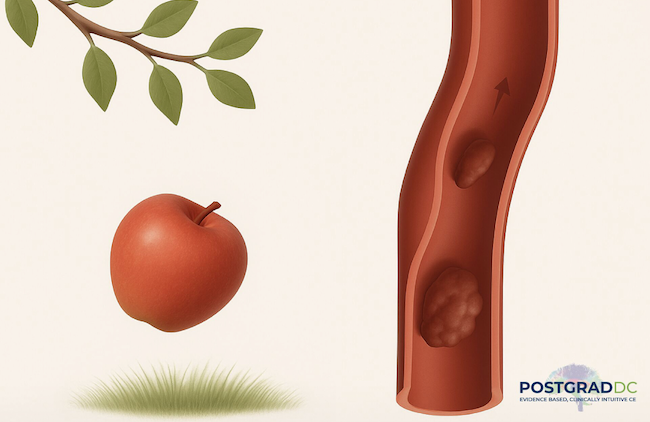Is an Immediate Thromboembolic Event Following Chiropractic Manipulation Causally Related or an Independent Spontaneous Occurrence?
Written by: James Demetrious, DC, DABCO
Introduction
The occurrence of a cerebrovascular event immediately following chiropractic cervical manipulation has long been a subject of debate. The central question is whether temporal proximity implies causation, or whether such events are simply spontaneous and coincidental manifestations of an underlying vascular pathology. A careful review of the evidence reveals that temporal association alone is insufficient to establish causality.
Natural History of Thromboembolic Events
The pathophysiology of cerebrovascular events following arterial dissection may be associated with the formation of an unstable mural thrombus and spontaneous embolization. The occurrence of a thromboembolic event after manipulation is best understood as the culmination of the lesion’s unpredictable biology, not as a consequence of spinal care.
Temporal Association vs. Causation
Studies indicate that the highest stroke risk occurs within the first two weeks following dissection, but the timing of ischemia remains variable. This variability underscores that temporal proximity to chiropractic care is not sufficient evidence of causation. Temporal proximity often creates a misleading impression of cause and effect. However, temporal association is not equivalent to causal linkage.
Large population-based analyses have shown that patients who experience vertebrobasilar stroke were equally likely to have visited a chiropractor or a primary-care physician in the days preceding the event, strongly suggesting protopathic bias (care sought for early dissection symptoms) rather than causation. Without biomechanical plausibility or evidentiary support, attributing causality to manipulation misrepresents the natural course of vascular disease.
Biomechanical Evidence
Biomechanical and strain-gauge studies have repeatedly demonstrated that cervical spinal manipulation produces vertebral artery elongation and strain well below injury thresholds. Symons et al. reported internal forces far less than known failure values, while Herzog et al. confirmed that high-velocity, low-amplitude thrusts generated lower strain than everyday neck movements .
More recent cadaveric and motion-analysis work confirms that vertebral arteries do not undergo injurious tensile strain during manipulation. This data underscore the absence of a dose-response relationship, mechanistic rationale, or reproducible evidence linking manipulation to arterial injury or thromboembolism. These findings eliminate a plausible biomechanical rationale for direct injury during manipulation.
Clinical Perspective
The apple tree analogy is instructive: we know the apple will eventually fall, but the exact timing is unpredictable. But what if somebody shakes the tree? Wouldn’t that make the apple fall? What if a Chiropractor adjusts a patient with a thrombus? Isn’t it possible that it could cause thromboembolism? Unlike the apple tree analogy, strain analysis indicates that spinal manipulation produces less strain than daily activities. Large studies preclude this causal association.
A Difficult Diagnosis
The real challenge for clinicians lies in recognizing dissections early. Symptoms such as sudden severe neck pain, headache, or neurological deficits require timely referral for medical evaluation. Yet arterial dissection may remain silent until embolization occurs, making diagnosis inherently difficult.
High rates of medical diagnostic error are well-documented. Despite these challenges, chiropractors must maintain vigilance, should not be misattributed as causal agents of care and should be offered reasonable consideration with regard to standard of care for this extraordinary difficult diagnosis.
Conclusion
Current evidence does not demonstrate a causal relationship between chiropractic cervical manipulation and thromboembolic events. The natural history of arterial dissection, the presence of highly powered studies that affirm safety, and biomechanical safety data, reinforces the conclusion that chiropractic manipulation produces strain that is well below injurious thresholds and is not a precipitating factor for thromboembolism. Patient safety lies in the communication of salient patient history and early recognition, if possible, of dissection symptoms and neurologic sequelae to make timely medical referrals.
References
References associated with this article are available in our PostGradDC coursework.
Disclosure
The information provided in this article and all PostGradDC coursework should not be considered standards of care. We provide this information for educational purposes only. This information is not intended to be a substitute for professional medical advice, diagnosis, or treatment. Always consult your physician or a qualified healthcare provider with any questions you may have regarding medical conditions or treatment. Seek the opinion of your legal representative. Errors and omissions are unintended.
Conflict of Interest Statement
Dr. James Demetrious is a board-certified chiropractic orthopedist and the founder and CEO of PostGradDC (PostGradDC.com), a privately operated provider of chiropractic continuing education. Dr. Demetrious is an independent member of the NCMIC Speakers’ Bureau. Dr. Demetrious teaches coursework on behalf of chiropractic colleges, state, and national organizations. Dr. Demetrious has published peer-reviewed research on these topics and provides consultation services to chiropractic physicians, attorneys, and professional organizations.
This commentary was written independently and without external funding. While his educational and advocacy activities promote evidence-based chiropractic practice, the views expressed herein are his own and are based on an interpretation of the current scientific literature. Any omissions are unintended, and concerns about COI can be amended.

PostGradDC offers advanced post-graduate chiropractic continuing education. Our founder, Dr. James Demetrious, is a distinguished board-certified chiropractic orthopedist, educator, author, and editor.
© 2025 – James Demetrious, DC, DABCO. Open Access. Unrestricted use, distribution, and reproduction are allowed in any medium, provided you give appropriate credit by citing the original author and source: Demetrious J. PostGradDC. Is an Immediate Thromboembolic Event Following Chiropractic Manipulation Causally Related or an Independent Spontaneous Occurrence? PostGradDC.com; 2025.

